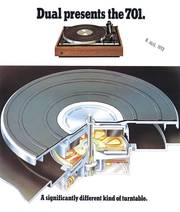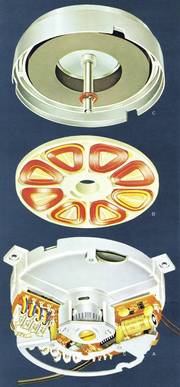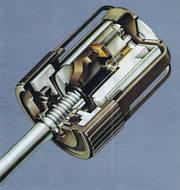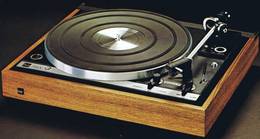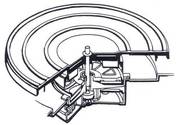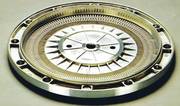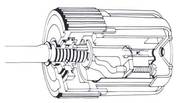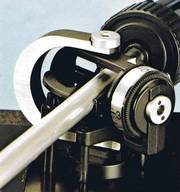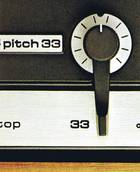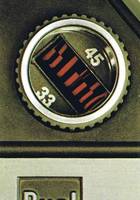Aug. 1973 - Hier der englische (amerikanische) Prospekt des neuen Dual 701 mit dem EDS "direct-drive system"- Motor
In den für den amerikanischen Markt getexteten Prospekten fällt immer wieder die wortgewaltige Übertreibung vieler oft nebensächlicher Eigenschaften auf. Weiterhin war dort das Wettbewerbsrecht viel harmloser als bei uns in Deutschland. Also die gezielte indirekte Unterstellung bestimmter Negativeigenschaften von anderen Konkurrenz-Produkten war dort in Grenzen erlaubt und Usus.
Als zum Beispiel die weltmarktführende amerikanische "PAN American Airways" in ganzseitigen Anzeigen schwärmte, sie habe weltweit "die größte Erfahrung im Fliegen", konterte die "American Airlines" mit ganzseitigen Antwort-Anzeigen : "Ja, das stimmt, - aber nur schlechte - (yes, its true, but bad experience only)."
Deshalb warben die Japaner in den USA ab 1977/78 mit Anzeigen, in denen die Wechsler-Automatiken und die sonstigen Hilfs-Automatiken - selbst hochwertigster Spieler - zugunsten simpelster bzw. primitivster angeblich purer (aber eher primitiver und billiger) Technik diskreditiert wurden.
Immer wenn in den USA das Attribut "value" auf einer Anzeige bei irgendeinem Produkt steht, handelt es sich um das "Billigste vom Billigen". Die Japaner hatten zunehmende Erfolge mit den billigsten manuellen "Gurken" und Dual verlor Prozent für Prozent Marktanteil. Schlimm ist (war) nur, daß das vom amerikanischen Importeur und dem deutschen DUAL- Auslandsmarketing viel zu spät korrigiert wurde oder gegenzusteuern versucht wurde. Eine Seite über Dual in den USA finden Sie hier.
.
The Dual 701 and its state-of-the-art performance.
The Dual 701 is the quietest turntable ever made. Not only in our judgment, but in that of the first independent test laboratory to evaluate its performance. This has been accomplished by an entirely different kind of motor, designed expressly for the 701, and by a very innovative approach to the problem of resonance.
Instead of the familiar, high-speed AC motor, the 701 has an all-electronic, low-speed, DC motor, with feedback-controlled speed precision. Because this motor rotates at the record speed, 33-1/3 or 45 rpm, the need for speed-reduction systems such as friction-idler or rim-belt is eliminated. Instead, the platter is rotated directly by the motor, and the record spindle is the top of the motor shaft.
The 701 motor is so quiet and free from vibration that it does not require any isolation mounting, but is mounted directly to the chassis. Dual's exclusive design of overlapping coils, a unique feature of the motor, eliminates the successive pulses common to every other existing motor, including other electronic types, high speed or low speed.
Another Dual innovation serves to prevent interference from reaching and affecting the stylus. Two separate anti-resonance filters, each tuned to a specific resonance range, are located within the counterbalance housing. One filter is tuned to the resonant range of the tonearm / cartridge system; the other, to the resonant range of the chassis. Each filter serves to cancel out the resonant energy that would otherwise impart spurious signals to the stylus.
For those who would like to know more about the 701 motor and the anti-resonance filters, a detailed description of both is provided on the back page.
Other features of the 701 - the gimbal tonearm suspension, anti-skating and pitch-control - are shown and described on the facing page. Still others include direct-dial tracking pressure, with 0.10 gram calibrations from 0 to 1.5 grams. And, a cue-control, silicone-damped in both directions. Unlike other Dual turntables, the 701 is designed for only single-play. But - like other Duals, it can be operated either fully automatically, or as a manual turntable.
Because of the unique motor and anti-resonance filters, the 701 is slightly quieter than the 1229. But if you now own a 1229, or any other current Dual, you will detect only a minor difference. And we don't suggest that you trade in your present Dual for the 701.
Rather, as an expression of the state of the art, the 701 is recommended for the listener who demands the quietest turntable ever made. Its price: $350.00, including base and dust cover.
The high level of performance already achieved by Dual turntables raises an appropriate question about the new 701: How does it still further improve the quality of record playback?
Dual turntables have for years been preferred by serious music lovers, including record reviewers and others professionally engaged in high fidelity. Test reports by independent laboratories have repeatedly rated Duals as equalling or surpassing the performance of professional turntables. In addition, knowledgable readers of the leading high fidelity/equipment magazines continue to purchase more Duals than any other make of quality turntables.
Why then the 701?
The requirements in record playback are far more demanding than those of ten years ago when Dual introduced the 1009, the first record changer to rival the best of the manual turntables.
At that time, no cartridge existed that could track well at under two grams. Today's best cartridges, of course, can track optimally at below one gram. And typically, an advance in one component requires advances in others.
For example, cartridges capable of very low tracking pressure require tonearms with extremely low bearing friction. And since low bearing friction increases the skating effect, highly accurate anti-skating systems are needed to assure equal tracking pressure on both stereo sidewalk
Most recently, the advent of the four-channel record, with two signal sources on each groove wall, have made tonearm performance even more critical.Two other factors affecting the stylus also have taken on increased importance: motor vibration and tonearm resonance.
It is in these two areas that you will find most of the answers to the question: why the 701?
Electronically-regulated, direct-drive motor with exclusive overlapping coil system.
The bottom element (A) houses the solid state components, including integrated circuits, which comprise the switching, commutation and regulator circuits.
Element (B) shows one of the field-coil assemblies, each containing eight bifilar-wound coils. The two sets of coils are offset by 22-1/2" thus providing a continuously rotating field. Hall-effect devices are located in each layer.
The rotor (element C) and platter turn at the selected speed.
Full-size 12" dynamically balanced, die-cast platter.
The 701 platter rests directly on the rotor and rotates with it at the selected speed. Every platter is cast from a single piece of special zinc alloy which is then individually machined and balanced while rotating at high speed. Any imbalances, however minute, are graphically revealed by computerized gauges and precisely corrected. The platter's full twelve-inch diameter, 9.7 pounds of weight (platter plus rotor) and perfect dynamic balance combine to provide optimum flywheel effect.
Resonance-cancelling filters integral with counterbalance
Cutaway view reveals the intricate engineering of the 701 's unique counterbalance which houses two separate mechanical filters. These filters absorb resonant energy in the frequency ranges of the tonearm/cartridge system and the chassis. The result is flatter frequency response and greater isolation from acoustical feedback.
Tonearm mounted in four-point low friction gimbal suspension.
The 701 tonearm pivots on identical sets of low-friction needle-point bearings, set in a special designed double gimbal. Each gimbal is hand-assembled, and gauges designed by Dual assure that bearing friction will conform to stringent specifications.
Separate anti-skating for conical and elliptical styli.
Balanced tracking pressure on groove sidewalls is assured by separate calibrations for conical and elliptical styli. This provision is required in such low-friction tonearms which are highly responsive to the difference in frictional pull of each stylus shape.
8% pitch-control range for each speed, and built-in illuminated strobe.
An electronic pitch-control, variable over an 8% range, is provided for each of the 701 's two speeds (33-1/3 and 45 rpm.) Thus, either speed can be varied without affecting the other setting. Each pitch-control is provided with a reference setting for standardization. For viewing convenience, the illuminated strobe window has an adjustable angle, from directly overhead to approximately 20 degrees forward.
The Dual 701, a model of understated technology.
The 701's appearance is deceptively simple. Since all mechanisms for tonearm settings and speed controls are housed internally, a mere look at the 701 gives little hint of its high degree of sophistication. It does, however, indicate the simplicity of operation. In automatic play, all start and stop functions are controlled by a single switch. In manual play, the turntable is started by simply moving the tonearm toward the record. And in either mode, play may be interrupted any time by lifting the tonearm manually or with the cue control. Moreover, the 701 is designed to maintain original performance standards throughout years of constant use.
.

